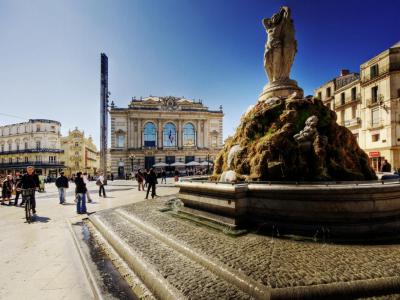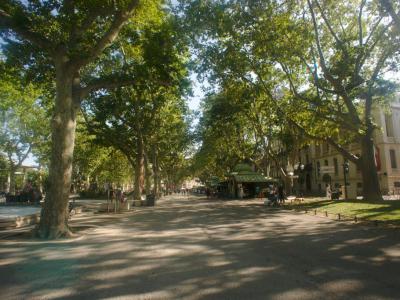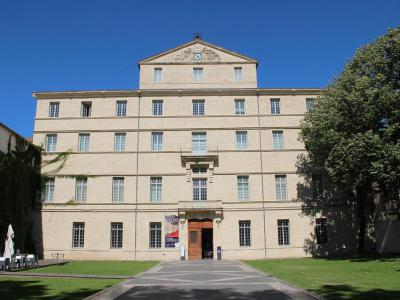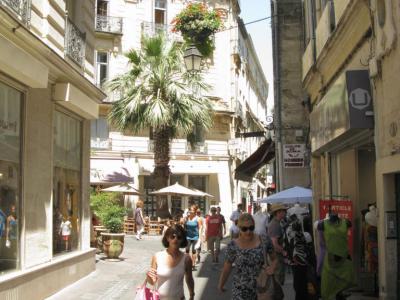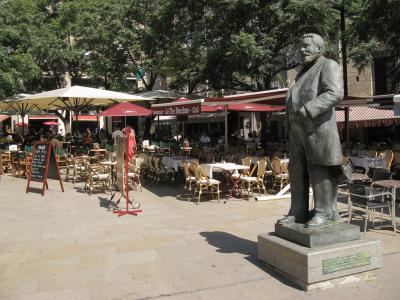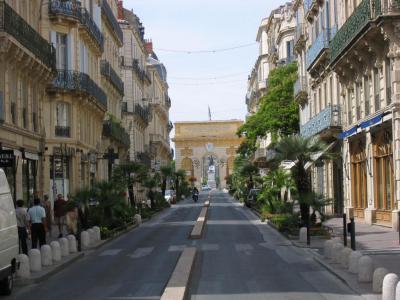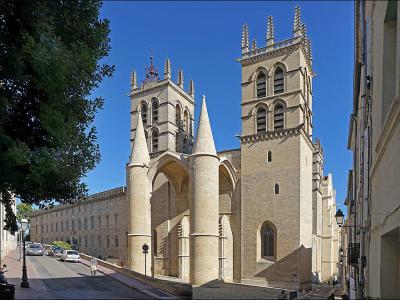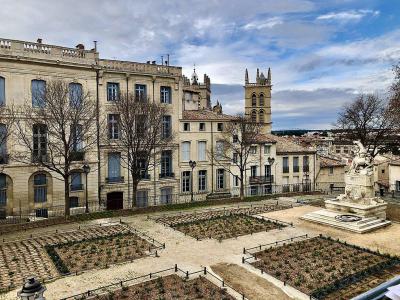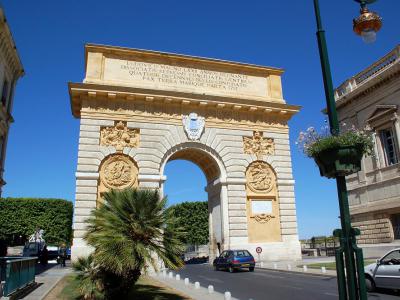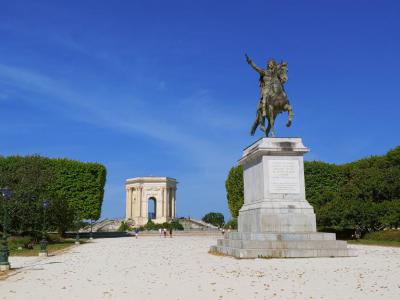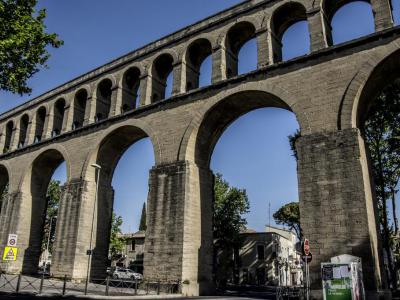Montpellier Introduction Walking Tour (Self Guided), Montpellier
The trouble with living in a pleasant seaside town in the middle ages was pirates. This was especially true for the town of Maguelone on the south shore of present-day France. A settlement more inland was combined with Maguelone under the feudal dynasty of Guilhem in 985. They added a castle and walls and called it Montpellier.
Montpellier was an important trading center in the 12th century and remained so until it was surpassed by Marseilles in 1481. The 16th century brought many changes. Chief among them was the Protestant Reformation. Montpellier became a Huguenot stronghold. Louis XIII conquered the city in 1622 and built the city Citadel to keep it.
Louis XIV, the "Sun King", made Montpellier the capital of Lower Landueduc. The city entered a new era of building and civic improvements. The Peyrou Promenade, the Water Castle and the 18th century Saint Clement Aqueduct serviced the town.
In the 19th century many elegant mansions appeared in the historic center of the city. The Corum and the Opera Berlioz emerged. The center of attention goes to the Comedy Square with the Opera Comedy from 1888. The Gate of Peyrou is a great way to walk into the old section of town.
The 14th century fortified Montpellier Cathedral awes visitors with its rocket-like towers. The Amazon Greenhouse is a tropical rain forest gallery. The Montpellier Plant Garden, founded in 1593, is the oldest botanical garden in France. The University of Montpellier was founded in 1160. French writer François Rabelais received his degree in medicine there in 1530.
Montpellier is a cherished crossroad of the Mediterranean. So it has been from the 12th century until now. Sunshine (most of the year), delicious food, historical sights and neighborhoods, and world class universities and museums (students make up almost 1/3 of the population) and much more. Many travelers come here. Many travelers stay.
Montpellier was an important trading center in the 12th century and remained so until it was surpassed by Marseilles in 1481. The 16th century brought many changes. Chief among them was the Protestant Reformation. Montpellier became a Huguenot stronghold. Louis XIII conquered the city in 1622 and built the city Citadel to keep it.
Louis XIV, the "Sun King", made Montpellier the capital of Lower Landueduc. The city entered a new era of building and civic improvements. The Peyrou Promenade, the Water Castle and the 18th century Saint Clement Aqueduct serviced the town.
In the 19th century many elegant mansions appeared in the historic center of the city. The Corum and the Opera Berlioz emerged. The center of attention goes to the Comedy Square with the Opera Comedy from 1888. The Gate of Peyrou is a great way to walk into the old section of town.
The 14th century fortified Montpellier Cathedral awes visitors with its rocket-like towers. The Amazon Greenhouse is a tropical rain forest gallery. The Montpellier Plant Garden, founded in 1593, is the oldest botanical garden in France. The University of Montpellier was founded in 1160. French writer François Rabelais received his degree in medicine there in 1530.
Montpellier is a cherished crossroad of the Mediterranean. So it has been from the 12th century until now. Sunshine (most of the year), delicious food, historical sights and neighborhoods, and world class universities and museums (students make up almost 1/3 of the population) and much more. Many travelers come here. Many travelers stay.
How it works: Download the app "GPSmyCity: Walks in 1K+ Cities" from Apple App Store or Google Play Store to your mobile phone or tablet. The app turns your mobile device into a personal tour guide and its built-in GPS navigation functions guide you from one tour stop to next. The app works offline, so no data plan is needed when traveling abroad.
Montpellier Introduction Walking Tour Map
Guide Name: Montpellier Introduction Walking Tour
Guide Location: France » Montpellier (See other walking tours in Montpellier)
Guide Type: Self-guided Walking Tour (Sightseeing)
# of Attractions: 11
Tour Duration: 2 Hour(s)
Travel Distance: 2.2 Km or 1.4 Miles
Author: Cathy
Sight(s) Featured in This Guide:
Guide Location: France » Montpellier (See other walking tours in Montpellier)
Guide Type: Self-guided Walking Tour (Sightseeing)
# of Attractions: 11
Tour Duration: 2 Hour(s)
Travel Distance: 2.2 Km or 1.4 Miles
Author: Cathy
Sight(s) Featured in This Guide:
- Place de la Comédie (Comedy Square)
- Charles-de-Gaulle Esplanade
- Fabre Museum
- Rue de l'Aiguillerie (Needlework Street)
- Place Jean Jaures ( Jean Jaures Square)
- Rue Foch (Foch Street)
- Montpellier Cathedral
- Place de la Canourgue (Canourgue Square)
- Porte du Peyrou (Gate of Peyrou)
- Promenade du Peyrou (Peyrou Promenade)
- Montpellier Aqueduct
1) Place de la Comédie (Comedy Square) (must see)
Comedy Square is called a square. But it is not a square. It is an oval. For this reason, locals often refer to it as "the Egg". It is shaped like an egg and it is one of the largest "squares" in Europe. It is located in the heart of the medieval city.
The square extends across the space once occupied by the ancient fortifications of Montpellier, almost touching the Joffre High School (formerly the citadel of Montpellier) and the Charles de Gaulle Esplanade in the east. It is about 756 feet long by 164 feet wide.
The earliest mention of the square is 1755. It was named for the Municipal Theatre, Opera Comedy. The theater burned down twice, the first time in 1785 and then again in 1881. Each time it was rebuilt.
In 1790 The fountain and sculpture of the three Graces, Euphrosyne, Aglaea and Thalia, by the well known French sculptor Étienne Dantoine, was installed in the square. The Graces were the daughters of Zeus. Thalia was Youth, Euphrosyne was Humor and Aglaea was Elegance; three qualities prized in France.
The square extends across the space once occupied by the ancient fortifications of Montpellier, almost touching the Joffre High School (formerly the citadel of Montpellier) and the Charles de Gaulle Esplanade in the east. It is about 756 feet long by 164 feet wide.
The earliest mention of the square is 1755. It was named for the Municipal Theatre, Opera Comedy. The theater burned down twice, the first time in 1785 and then again in 1881. Each time it was rebuilt.
In 1790 The fountain and sculpture of the three Graces, Euphrosyne, Aglaea and Thalia, by the well known French sculptor Étienne Dantoine, was installed in the square. The Graces were the daughters of Zeus. Thalia was Youth, Euphrosyne was Humor and Aglaea was Elegance; three qualities prized in France.
2) Charles-de-Gaulle Esplanade
It was after the siege of Montpellier in 1622 that Louis XIII ordered some ramparts demolished to improve sight lines for the artillery pieces in the Citadel.
By 1679 the bastions and walls had been taken down around the common area and the deep moat by the Gate of Lattes was filled in. Later a military drill field was created for the soldiers based in the neighboring fort, the Citadel.
The military drill field was sold by the army to the town and transformed into an esplanade in 1900. There emerged fountains, numbers of statues and a monument to All The Dead of All the Wars. At first the monument was close to the Corum Palace, home of Opera Belioz. An inscription on the cornice reads, "Montpellier to her children dead for France."
The Esplanade is really an extension of the Comedy Square. It holds the Garden of the Fields of Mars, fountains, the Fabre Museum, the Museum of France, the Corum, a statue of Jean-Jaures, a bust of General de Gaulle, and kiosks of food.
By 1679 the bastions and walls had been taken down around the common area and the deep moat by the Gate of Lattes was filled in. Later a military drill field was created for the soldiers based in the neighboring fort, the Citadel.
The military drill field was sold by the army to the town and transformed into an esplanade in 1900. There emerged fountains, numbers of statues and a monument to All The Dead of All the Wars. At first the monument was close to the Corum Palace, home of Opera Belioz. An inscription on the cornice reads, "Montpellier to her children dead for France."
The Esplanade is really an extension of the Comedy Square. It holds the Garden of the Fields of Mars, fountains, the Fabre Museum, the Museum of France, the Corum, a statue of Jean-Jaures, a bust of General de Gaulle, and kiosks of food.
3) Fabre Museum (must see)
Francois-Xavier Fabre, student of Jacques-Louis David, winner of the Rome Prize for art in 1787, married the Princess Louise of Stolberg-Gedem. She was very rich. When she passed away in 1824, Francois inherited her wealth and used it to found an art school in his hometown of Montpellier.
Back in 1802, Montpellier received a gift of 30 paintings. This was the beginning of small city museum. Fabre died in 1837. He left 100 more paintings to the museum. His collections formed the basis of the Fabre Museum. The museum is housed in a large four-story building close to the Comedy Square in the center of town.
Other renown artists contributed to the collection. The museum is classified as a Museum of France by the French Ministry of Culture.
The museum holds an impressive collection of ancient European ceramics and paintings from the 15th to the 20th centuries. Painters and sculptors from France, Italy, Spain, Britain, the Low Countries and other European nations are well represented.
Back in 1802, Montpellier received a gift of 30 paintings. This was the beginning of small city museum. Fabre died in 1837. He left 100 more paintings to the museum. His collections formed the basis of the Fabre Museum. The museum is housed in a large four-story building close to the Comedy Square in the center of town.
Other renown artists contributed to the collection. The museum is classified as a Museum of France by the French Ministry of Culture.
The museum holds an impressive collection of ancient European ceramics and paintings from the 15th to the 20th centuries. Painters and sculptors from France, Italy, Spain, Britain, the Low Countries and other European nations are well represented.
4) Rue de l'Aiguillerie (Needlework Street)
Needlework Street is a commercial street of the commune of Montpellier. It is located in a pedestrianized zone in the center of town. At its southern end it borders the Jean-Jaures Square and the Lodge Street. This is the street for bars, alternative shops, ecological and foreign cultural venues.
Needlework Street in Montpellier shares this name with a street in Paris. The "needlework" is all types of craftsmanship with fabrics; handicrafts. In former times the Needlework Street was a street featuring handicraft tradesmen, working mostly from home. The craftsmen are long gone. Only the name remains.
The street is among the largest and well known streets in Montpellier. It is a popular and busy street of shops, restaurants and fast-food stalls and student hang-outs. It is easy walking at any time.
Needlework Street in Montpellier shares this name with a street in Paris. The "needlework" is all types of craftsmanship with fabrics; handicrafts. In former times the Needlework Street was a street featuring handicraft tradesmen, working mostly from home. The craftsmen are long gone. Only the name remains.
The street is among the largest and well known streets in Montpellier. It is a popular and busy street of shops, restaurants and fast-food stalls and student hang-outs. It is easy walking at any time.
5) Place Jean Jaures ( Jean Jaures Square)
Jean Jaures was a prominent French socialist politician assassinated in the early 20th century for his pacifist stance against the Great War. His killer was a nationalist aptly named Raoul Villain. Jean Jaures was buried in the Pantheon in Paris in 1924.
The Jean Jaures Square is in the medieval area of Montpellier. It borders the Lodge Street at its intersection with the Needleword Street. The square is a pedestrian rectangle measuring about 164 feet on each side. There is a statue of Jean Jaures and bars with terraces shaded by plane trees.
The square fills the space opened up by the 1794 demolition of the old church Our Lady of the Tablets. The church dated from the 11th century. It had the name Our Lady of the Tablets because of the money changers that did their business inside. It should not be confused with the other church of Our Lady, also situated in the area.
Underneath the square is the crypt of the old church. It is reached by a staircase. The crypt is now the site of the Museum of the History of Montpellier.
The square is a popular place for young people. There are many bars and restaurant terraces on the square.
The Jean Jaures Square is in the medieval area of Montpellier. It borders the Lodge Street at its intersection with the Needleword Street. The square is a pedestrian rectangle measuring about 164 feet on each side. There is a statue of Jean Jaures and bars with terraces shaded by plane trees.
The square fills the space opened up by the 1794 demolition of the old church Our Lady of the Tablets. The church dated from the 11th century. It had the name Our Lady of the Tablets because of the money changers that did their business inside. It should not be confused with the other church of Our Lady, also situated in the area.
Underneath the square is the crypt of the old church. It is reached by a staircase. The crypt is now the site of the Museum of the History of Montpellier.
The square is a popular place for young people. There are many bars and restaurant terraces on the square.
6) Rue Foch (Foch Street)
Foch Street was originally Peyrou Street, a commune road of Montpellier established in 1205 with the construction of the second fortification of the town. Known as a "cloture commune", it allowed access to the gate of the Rampart called the Gate of Peyrou.
Foch Street is a commercial artery in the town center. The street begins in the west by the Francois Franque Street, adjoining the promenade Peyrou. It passes over the Vialleton Bridge and under the Arch of Triumph. Cut by the the Square of the Martyrs of the Resistance, it ends in the east at the Needlework Street.
Following the urban renewal trends during the reign of Napoleon III in Paris, Montpellier also made Haussmannian adjustments and enlargements to some of its streets. So the Peyrou Street became the Imperial Street in 1864. During the Third Republic the name was changed again to National Street.
Ferdinand Foch was a French general and military theorist who served during World War I. Known for his aggressive military style, Foch became the Allied Commander-in-Chief in late March 1918 in the face of the all-out German spring offensive. He successfully coordinated the French, British and American troops into a coherent whole, stopped the German offensive and launched a war-winning counterattack.
One month after the death of Marshal Foch in 1929, the street was renamed to Foch Street.
Foch Street is a commercial artery in the town center. The street begins in the west by the Francois Franque Street, adjoining the promenade Peyrou. It passes over the Vialleton Bridge and under the Arch of Triumph. Cut by the the Square of the Martyrs of the Resistance, it ends in the east at the Needlework Street.
Following the urban renewal trends during the reign of Napoleon III in Paris, Montpellier also made Haussmannian adjustments and enlargements to some of its streets. So the Peyrou Street became the Imperial Street in 1864. During the Third Republic the name was changed again to National Street.
Ferdinand Foch was a French general and military theorist who served during World War I. Known for his aggressive military style, Foch became the Allied Commander-in-Chief in late March 1918 in the face of the all-out German spring offensive. He successfully coordinated the French, British and American troops into a coherent whole, stopped the German offensive and launched a war-winning counterattack.
One month after the death of Marshal Foch in 1929, the street was renamed to Foch Street.
7) Montpellier Cathedral (must see)
Saint Peter's Cathedral is the enlargement of the former Benedictine convent chapel dedicated to Saints Benedict and Germain, founded by Pope Urban V in 1364. The chapel became a cathedral in 1536. The building is in the center of the old town. It is a Gothic style version of a medieval "fortress" cathedral.
Four imposing towers are set at the corners of the nave. Before the entrance is a great porch supported by two massive cylindrical pillars topped with inverted cone-shaped spires. The pillars are connected to the facade by a vaulted roof. The main entrance itself is flanked by two pilasters with conical tops.
The church is a single vessel with one nave. There are five bays harboring 14 side chapels. The chapels are dedicated to: Our Lady, Saints Germain, Victor, Cecilia, Martin, Catherine, Peter, Magdalene, Lazarus and Michael. We must also not overlook Saint Ursula and the eleven thousand virgins, the Holy Cross and Saint Blaise.
The high altar is veiled with a vermeil altarpiece. There are two sacristies, major and minor, containing books, relics, reliquaries and sacred vessels. There are relics of Saint Germain and Saint Blaise and Saint Benedict's silver arm.
In 1906 the cathedral was classified as a historical monument. In 2002, by decree of the Congregation of Bishops, it became a metropolitan cathedral.
Four imposing towers are set at the corners of the nave. Before the entrance is a great porch supported by two massive cylindrical pillars topped with inverted cone-shaped spires. The pillars are connected to the facade by a vaulted roof. The main entrance itself is flanked by two pilasters with conical tops.
The church is a single vessel with one nave. There are five bays harboring 14 side chapels. The chapels are dedicated to: Our Lady, Saints Germain, Victor, Cecilia, Martin, Catherine, Peter, Magdalene, Lazarus and Michael. We must also not overlook Saint Ursula and the eleven thousand virgins, the Holy Cross and Saint Blaise.
The high altar is veiled with a vermeil altarpiece. There are two sacristies, major and minor, containing books, relics, reliquaries and sacred vessels. There are relics of Saint Germain and Saint Blaise and Saint Benedict's silver arm.
In 1906 the cathedral was classified as a historical monument. In 2002, by decree of the Congregation of Bishops, it became a metropolitan cathedral.
8) Place de la Canourgue (Canourgue Square)
Canourque Square is the oldest, most pleasant square in Montpellier. It was developed over the ruins of a church. It is located in the old city. It is bordered in the north by Saint Pierre Street, in the east by City Hall Street and in the south and west by Sainte-Croix Street.
In 1129, Guilhem VI, Lord of Montpellier, chose to build his palace and an oratory on the future site of the Canourgue Street. Guilhem placed a piece of the true cross in his oratory. The oratory was destroyed during the religious wars in 1562.
The Confraternity of White Penitents rebuilt the sanctuary. This chapel was also destroyed in another war of religion. The Penitents decided to place Guilhem's True Cross on a stone column instead and that was destroyed in 1791.
The Fountain of Unicorns, created in 1776, was transferred to the square in 1863. The sculptures on the fountain are struggling sea horses and unicorns and a human figure. The memorial is in honor of the Marquis de Castries for his victory in the Battle of Clostercamp in 1760.
Today the square is lined with buildings from the 17th century. The replacement for the stone column of the True Cross, destroyed in 1791, can be seen in the square.
In 1129, Guilhem VI, Lord of Montpellier, chose to build his palace and an oratory on the future site of the Canourgue Street. Guilhem placed a piece of the true cross in his oratory. The oratory was destroyed during the religious wars in 1562.
The Confraternity of White Penitents rebuilt the sanctuary. This chapel was also destroyed in another war of religion. The Penitents decided to place Guilhem's True Cross on a stone column instead and that was destroyed in 1791.
The Fountain of Unicorns, created in 1776, was transferred to the square in 1863. The sculptures on the fountain are struggling sea horses and unicorns and a human figure. The memorial is in honor of the Marquis de Castries for his victory in the Battle of Clostercamp in 1760.
Today the square is lined with buildings from the 17th century. The replacement for the stone column of the True Cross, destroyed in 1791, can be seen in the square.
9) Porte du Peyrou (Gate of Peyrou)
The Gate of Peyrou, also called Triumphal Arch, can be found at the east end of the Peyou Park gardens in the center of Montpellier. It is almost fifty feet high and 59 feet wide. It was built in 1693 and designed by Francois Dorbay. Dorbay was perhaps inspired by the Parisian arch, the Gate of Dionysius, or even the Gate of Saint-Martin.
The Gate of Peyrou was dedicated to King Louis XIV, the "Sun King" of France. The Gate marks the entrance to the Royal Palace of Peyrou. It is within walking distance of the Saint-Clement Aqueduct offering a great view of the eastern part of the city.
The different stations of progress in King Louis XIV's reign are set into the facade of the arch. The shield and badge of the city of Montpellier are fixed at the top of the arch. There is a climb of 88 steps to the top of the Triumphal Arch. Every Sunday there is a flea market in the nearby Peyrou Square. One can shop here and think of the King.
The Gate of Peyrou was dedicated to King Louis XIV, the "Sun King" of France. The Gate marks the entrance to the Royal Palace of Peyrou. It is within walking distance of the Saint-Clement Aqueduct offering a great view of the eastern part of the city.
The different stations of progress in King Louis XIV's reign are set into the facade of the arch. The shield and badge of the city of Montpellier are fixed at the top of the arch. There is a climb of 88 steps to the top of the Triumphal Arch. Every Sunday there is a flea market in the nearby Peyrou Square. One can shop here and think of the King.
10) Promenade du Peyrou (Peyrou Promenade) (must see)
At the edge of the old town the city, is the Peyrou Promenade. The Triumph Arch honoring Louis XIV is here. There is also a statue of Louis on horseback erected in 1718. And close by is the neoclassical water tower and the 18th century aqueduct, reaching 14 kilometers to the Saint Clement spring.
The park dates from 1774, when Louis ascended the throne of France. It was designed and laid out by architect Jean Giral. Visitors to the park are rewarded with a panoramic view of the city and its surroundings. The Aqueduct of Saint Clement and its reservoir date from 1753. The cistern, called the Water Castle, was added in 1766.
There are the statues of children and a Lion by sculptor Injalbert of 1883. In 1927 a walk-in annualized sun dial was installed by Pierre Humbert. The promenade is 953 feet long and 529 feet in width. It has four entrances, three on the east side and one above the stairs on the west side. The main entrance is on the Francois Frank Street.
The park dates from 1774, when Louis ascended the throne of France. It was designed and laid out by architect Jean Giral. Visitors to the park are rewarded with a panoramic view of the city and its surroundings. The Aqueduct of Saint Clement and its reservoir date from 1753. The cistern, called the Water Castle, was added in 1766.
There are the statues of children and a Lion by sculptor Injalbert of 1883. In 1927 a walk-in annualized sun dial was installed by Pierre Humbert. The promenade is 953 feet long and 529 feet in width. It has four entrances, three on the east side and one above the stairs on the west side. The main entrance is on the Francois Frank Street.
11) Montpellier Aqueduct
The Montpellier Aqueduct, also known as the Saint-Clément or Arceaux Aqueduct, is a monumental structure that stands as a testament to 18th-century engineering ingenuity. Constructed between 1753 and 1765, the aqueduct was designed to transport water from the Saint-Clément spring, located 14 kilometers (8.7 miles) away, to the water tower in Peyrou Park, a key landmark at the western end of Montpellier’s city center.
The aqueduct’s most striking feature is its double layer of arches in the middle section, inspired by traditional Roman aqueducts. With 53 arches stretching over 800 meters (2,600 feet), the structure showcases a harmonious blend of practicality and aesthetics, making it an iconic piece of Montpellier’s urban landscape.
Built using local Castries stone, the aqueduct’s channels were lined with lead to prevent freezing during winter months, ensuring a consistent water supply year-round. The completion of this ambitious project silenced skeptics who had doubted its feasibility, and it became one of the largest private hydraulic projects ever undertaken in France.
Today, visitors can walk beneath the arches and marvel at the aqueduct’s intricate design. A popular time to visit is on Sundays, when the area around the Les Arceaux tram stop transforms into a bustling flea market, providing a lively backdrop to the historic structure. Nearby attractions such as the Montpellier Plant Garden, the Atger Museum, and the Fabre Museum make this part of the city a vibrant hub for history and culture enthusiasts.
The Montpellier Aqueduct not only served a crucial role in providing water to the city but also stands as a symbol of the vision and perseverance of the people who built it, bringing a piece of history into the heart of modern-day Montpellier.
The aqueduct’s most striking feature is its double layer of arches in the middle section, inspired by traditional Roman aqueducts. With 53 arches stretching over 800 meters (2,600 feet), the structure showcases a harmonious blend of practicality and aesthetics, making it an iconic piece of Montpellier’s urban landscape.
Built using local Castries stone, the aqueduct’s channels were lined with lead to prevent freezing during winter months, ensuring a consistent water supply year-round. The completion of this ambitious project silenced skeptics who had doubted its feasibility, and it became one of the largest private hydraulic projects ever undertaken in France.
Today, visitors can walk beneath the arches and marvel at the aqueduct’s intricate design. A popular time to visit is on Sundays, when the area around the Les Arceaux tram stop transforms into a bustling flea market, providing a lively backdrop to the historic structure. Nearby attractions such as the Montpellier Plant Garden, the Atger Museum, and the Fabre Museum make this part of the city a vibrant hub for history and culture enthusiasts.
The Montpellier Aqueduct not only served a crucial role in providing water to the city but also stands as a symbol of the vision and perseverance of the people who built it, bringing a piece of history into the heart of modern-day Montpellier.
Walking Tours in Montpellier, France
Create Your Own Walk in Montpellier
Creating your own self-guided walk in Montpellier is easy and fun. Choose the city attractions that you want to see and a walk route map will be created just for you. You can even set your hotel as the start point of the walk.
Murals and Street Art Walk
For those unaware, sunny Montpellier is more than just a quick getaway with a beautiful blue sky, sunshine, Mediterranean vibes and southern architecture. In fact, Montpellier is one of the few cities in France where all forms of street art, from elaborate murals to little gems that a passersby might not even notice right away, are found in rich supply, practically on every side street.
The... view more
Tour Duration: 1 Hour(s)
Travel Distance: 0.8 Km or 0.5 Miles
The... view more
Tour Duration: 1 Hour(s)
Travel Distance: 0.8 Km or 0.5 Miles
The Most Popular Cities
/ view all



